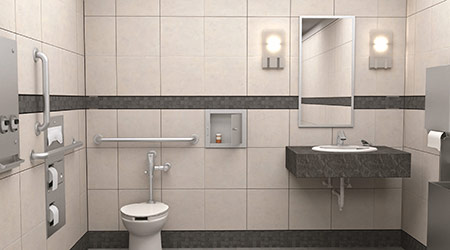According to an epidemiologic study conducted by the U.S. Department of Health and Human Services, falls occur at a rate of 3-5 per 1,000 bed-days, and according to the Agency for Healthcare Research and Quality, 700,000 to 1 million hospitalized patients are injured from falls each year. Approximately 30 to 51 percent of these result in injury, with the cost of a single fall injury averaging approximately $14,000, according to a Joint Commission report.
Healthcare facilities may be liable for some or all of these costs as a result of lawsuits filed, in many cases, for medical malpractice or ordinary negligence. In fact, falls cost U.S. hospitals approximately $34 billion per year in direct medical costs, according to the The Johns Hopkins Fall Risk Assessment Tool (JHFRAT), an evidence-based fall safety initiative.
The risk of slips and falls are compounded by some unique attributes of healthcare facility patients. Elderly patients may suffer from poor balance or decreased motor skills. Pain medications and anesthesia may have a similar affect. Factor in restroom environments where hands may be wet, and the risk to patients and facilities are amplified.
Areas within healthcare facilities that contain plumbing fixtures including showers, bathtubs and areas adjacent to toilets may result in “wet” areas, which further compound the risk of slips and falls.
In fact, due to the increased safety risks associated with wet hands, building codes in the U.S. and Canada mandate that grab bars be installed adjacent to plumbing fixtures, as is seen in the American Disabilities Act (ADA) Standards for Accessible Design. In Canada, the National Building Code of Canada (NBC) requires “slip-resistant” grab bar finishes in wet areas to provide additional traction.
In order to comply with relevant building codes and make a positive impact on patient safety, designers in both the U.S. and Canada should consider the importance of slip-resistant grab bar finishes while preparing their specifications.
Slip-Resistant Grab Bar Surfaces: Studies have shown that a slip-resistant grab bar surface can reduce the risk of a patient slipping or falling, which reduces the likelihood of injury and liability.
Slip-resistant grab bar finishes can also satisfy many national and provincial building codes in Canada. In the U.S., a slip-resistant grab bar surface would effectively exceed the ADA standard—to simply have grab bars installed in areas adjacent to plumbing fixtures.
Architects designing wet areas have historically specified peened- or knurled-finish grab bars to satisfy slip-resistance requirements, and as such, peened- and knurled-finish grab bars, which feature textured surfaces, are typically marketed as slip-resistant. Further, the NBC prior to 2015 required “peened” or “knurled” finishes in the code language.
In 2018, new test data revealed that satin-finish grab bars not only satisfy this requirement, but also provide superior grip performance in wet areas. The ASTM F2961 Grip Performance Test, while not required by any building code, is a methodology that can provide a quantitative measurement of an individual’s ability to grip a solid object and twist in a defined direction.
In September 2018, a test commissioned by Bobrick Washroom Equipment, Inc. and performed by Bureau Veritas Consumer Product Services, Inc. concluded that the slip-resistance of a satin-finish grab bar surface provides similar traction to a peened-finish grab bar when grabbed with a dry hand.
When grabbed with a wet hand, the surface of the satin-finish grab bar was found to provide 10 percent more traction than the surface of the peened-finish grab bar. For architects designing healthcare facilities, these new findings create new design opportunities.
Slip-resistance is not the only consideration when it comes to specifying grab bars. Modern analysis shows hygiene as a top priority in healthcare, and ease of cleaning is a concern. Satin-finish surfaces are generally easier to clean compared to peened and knurled finish grab bars.
Research shows that specifying a satin-finish grab bar surface can provide 10 percent more traction with a wet hand, while enhancing hygiene and reducing maintenance costs for healthcare facilities at the same time.
Canadian Building Code Implications: Individual Canadian provinces have adopted the 2015 NBC grab bar surface requirement, or have included similar language in their provincial building codes.
Previously, building codes throughout Canada required "peened" or "knurled" grab bar surfaces, though “slip-resistant was not included in the language. "Slip-resistant finish" is a recent inclusion, shifting the language from a type of grab bar surface to the resulting effect.
Today, many architects continue to specify grab bars with a “peened" or "knurled" finish. However, the new ASTM F2961 test data places “satin-finish” grab bars atop the consideration set with an emphasis on healthcare facilities that must satisfy the 2015 NBC, 2018 Canadian Standards Association (CSA) or various provincial codes.
While slip-resistant surfaces are not required in wet areas in the U.S., ADA standards require grab bars adjacent to plumbing fixtures. While the presence of grab bars satisfies the minimum standard, specifying a more slip-resistant grab bar for these applications exceeds the ADA requirement to provide added traction with a wet hand and supports universal or multigenerational design.
Specification Language for Slip-Resistant Grab Bar: Architects have been advised to take care when creating their specifications by avoiding copying previous projects, and using appropriate language that reflects the most recent building codes.
While years of archived specifications from projects past might still read “peened” or “knurled” finish, “satin-finish, slip-resistant surface” can now be specified with confidence.
Alan Gettelman is vice president of external affairs at Bobrick Washroom Equipment, Inc. Gettelman can be reached via e-mail at agettelman@bobrick.com.

 UF Health Hospitals Rely on Green Globes to Realize Their Full Potential
UF Health Hospitals Rely on Green Globes to Realize Their Full Potential How Healthcare Facilities Can Be Truly Disaster-Resilient
How Healthcare Facilities Can Be Truly Disaster-Resilient TriasMD Breaks Ground on DISC Surgery Center for San Fernando Valley
TriasMD Breaks Ground on DISC Surgery Center for San Fernando Valley Bigfork Valley Hospital Falls Victim to Data Breach
Bigfork Valley Hospital Falls Victim to Data Breach AI-Driven Facilities: Strategic Planning and Cost Management
AI-Driven Facilities: Strategic Planning and Cost Management